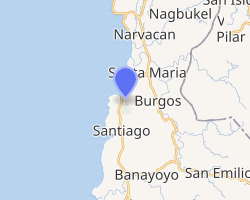San Esteban, Ilocos Sur
San Esteban, officially the Municipality of San Esteban (Ilocano: Ili ti San Esteban; Filipino: Bayan ng San Esteban), is a 5th class municipality in the province of Ilocos Sur, Philippines. According to the 2015 census, it has a population of 8,349 people.[3]
San Esteban | |
|---|---|
| Municipality of San Esteban | |
 | |
 Seal | |
 Map of Ilocos Sur with San Esteban highlighted | |

| |
.svg.png) San Esteban Location within the Philippines | |
| Coordinates: 17°20′N 120°27′E | |
| Country | |
| Region | Ilocos Region (Region I) |
| Province | Ilocos Sur |
| District | 2nd District |
| Barangays | 10 (see Barangays) |
| Government | |
| • Type | Sangguniang Bayan |
| • Mayor | Ray M. Elaydo II |
| • Vice Mayor | Ray A. Elaydo |
| • Congressman | Kristine Singson-Meehan |
| • Electorate | 5,970 voters (2019) |
| Area | |
| • Total | 19.62 km2 (7.58 sq mi) |
| Population (2015 census)[3] | |
| • Total | 8,349 |
| • Density | 430/km2 (1,100/sq mi) |
| • Households | 1,884 |
| Economy | |
| • Income class | 5th municipal income class |
| • Poverty incidence | 10.87% (2015)[4] |
| • Revenue (₱) | 146,496,161.13 (2016) |
| Time zone | UTC+8 (PST) |
| ZIP code | 2706 |
| PSGC | |
| IDD : area code | +63 (0)77 |
| Climate type | tropical monsoon climate |
| Native languages | Ilocano Tagalog |
San Esteban is 363 kilometres (226 mi) from Metro Manila and 44 kilometres (27 mi) from Vigan City, the provincial capital.
Etymology
The Spaniards named the pueblo (the equivalent of a municipality in present-day terms) San Esteban (formerly known as Cabagbagototan) because they have received reports of a vagabond named Iban having been stoned to death and beheaded by hostile natives in the place called "Naglawlawayan," which is an early place of worship by the natives, and currently the site of the municipal cemetery. "Iban" is the Ilocano equivalent of "Stephen," hence the pueblo being named San Esteban.
San Esteban was founded by Agustinian friars in 1625, but was always attached to Nueva Coveta (present-day Burgos) and to the municipality of Santiago until 1911. It was once a visita of Narvacan because of a shortage of ministers.
Barangays
San Esteban is politically subdivided into 10 barangays. [2]
- Ansad
- Apatot
- Bateria
- Cabaroan
- Cappa-Cappa
- Poblacion
- San Nicolas
- San Pablo
- San Rafael
- Villa Quirino
Climate
| Climate data for San Esteban, Ilocos Sur | |||||||||||||
|---|---|---|---|---|---|---|---|---|---|---|---|---|---|
| Month | Jan | Feb | Mar | Apr | May | Jun | Jul | Aug | Sep | Oct | Nov | Dec | Year |
| Average high °C (°F) | 30 (86) |
31 (88) |
33 (91) |
34 (93) |
33 (91) |
31 (88) |
30 (86) |
30 (86) |
30 (86) |
31 (88) |
31 (88) |
30 (86) |
31 (88) |
| Average low °C (°F) | 19 (66) |
20 (68) |
21 (70) |
23 (73) |
25 (77) |
25 (77) |
25 (77) |
25 (77) |
24 (75) |
22 (72) |
21 (70) |
20 (68) |
23 (73) |
| Average precipitation mm (inches) | 10 (0.4) |
10 (0.4) |
14 (0.6) |
23 (0.9) |
80 (3.1) |
103 (4.1) |
121 (4.8) |
111 (4.4) |
119 (4.7) |
144 (5.7) |
39 (1.5) |
15 (0.6) |
789 (31.2) |
| Average rainy days | 5.2 | 3.9 | 6.2 | 9.1 | 18.5 | 21.4 | 22.9 | 19.8 | 19.8 | 16.2 | 10.5 | 6.1 | 159.6 |
| Source: Meteoblue [5] | |||||||||||||
Demographics
|
| ||||||||||||||||||||||||||||||||||||||||||||||||
| Source: Philippine Statistics Authority[3][6][7][8] | |||||||||||||||||||||||||||||||||||||||||||||||||
In the 2015 census, the population of San Esteban, Ilocos Sur, was 8,349 people,[3] with a density of 430 inhabitants per square kilometre or 1,100 inhabitants per square mile.
References
- "Municipality". Quezon City, Philippines: Department of the Interior and Local Government. Retrieved 31 May 2013.
- "Province: Ilocos Sur". PSGC Interactive. Quezon City, Philippines: Philippine Statistics Authority. Retrieved 12 November 2016.
- Census of Population (2015). "Region I (Ilocos Region)". Total Population by Province, City, Municipality and Barangay. PSA. Retrieved 20 June 2016.
- "PSA releases the 2015 Municipal and City Level Poverty Estimates". Quezon City, Philippines. Retrieved 1 January 2020.
- "San Esteban: Average Temperatures and Rainfall". Meteoblue. Retrieved 14 May 2020.
- Census of Population and Housing (2010). "Region I (Ilocos Region)". Total Population by Province, City, Municipality and Barangay. NSO. Retrieved 29 June 2016.
- Censuses of Population (1903–2007). "Region I (Ilocos Region)". Table 1. Population Enumerated in Various Censuses by Province/Highly Urbanized City: 1903 to 2007. NSO.
- "Province of Ilocos Sur". Municipality Population Data. Local Water Utilities Administration Research Division. Retrieved 17 December 2016.